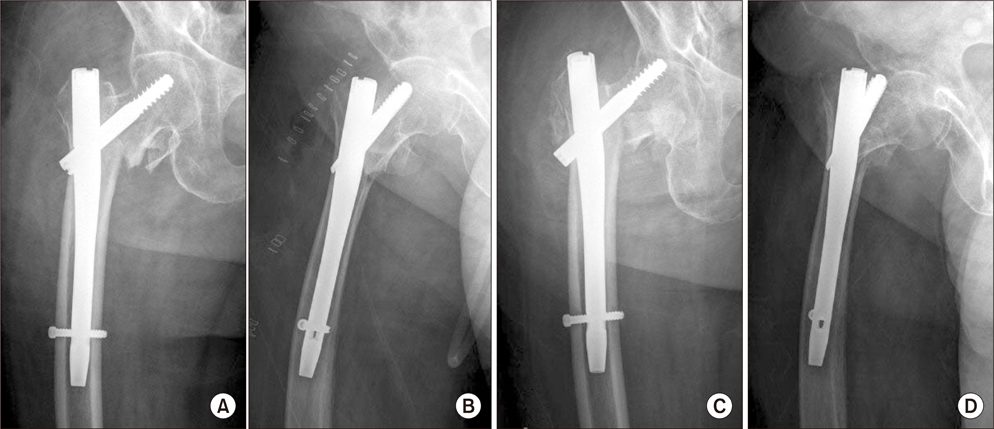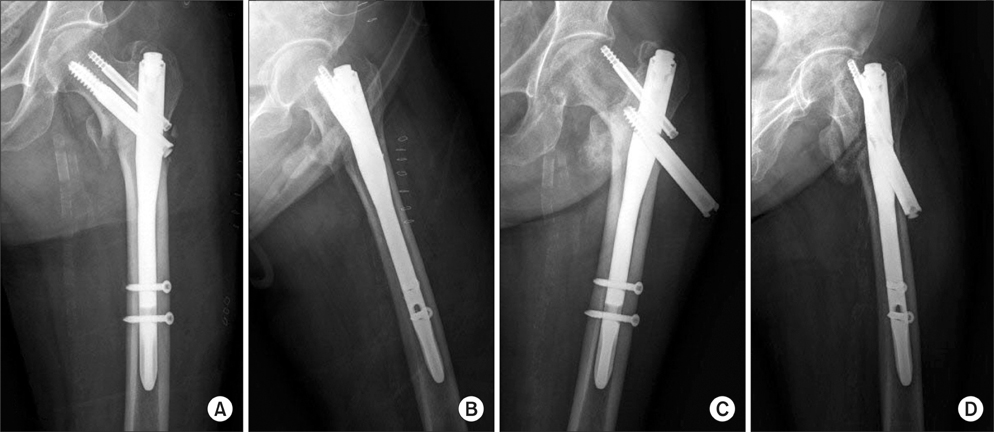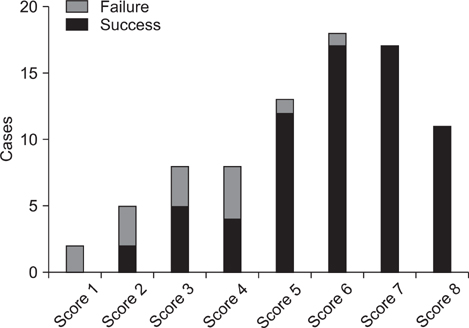Clin Orthop Surg.
2013 Mar;5(1):10-18. 10.4055/cios.2013.5.1.10.
The Stability Score of the Intramedullary Nailed Intertrochanteric Fractures: Stability of Nailed Fracture and Postoperative Patient Mobilization
- Affiliations
-
- 1Department of Orthopaedic Surgery and Traumatology, Cheju Halla General Hospital, Jeju, Korea. schstk27@hanmail.net
- KMID: 1402321
- DOI: http://doi.org/10.4055/cios.2013.5.1.10
Abstract
- BACKGROUND
Intertrochanteric fractures of the femur are the most common type of fracture, and are an increasing occurrence due to the aging of the population. The objectives of our study are to predict the fate of intertrochanteric fractures treated with intramedullary hip nails by assessing the postoperative fracture stability utilizing the newly developed scoring system, and to help rehabilitate these patients.
METHODS
Eighty-two patients with intertrochanteric fractures that were treated with intramedullary hip nails between December, 2004 and January, 2011 were subjected to this study. The patients who could be followed for a minimum of one year postoperatively were enrolled. The immediate postoperative conditions were determined by radiograms: reduction status (3 parameters/4 points: contact accuracy of posteromedial cortex, severity of angulation, and distraction), fixation status (3 parameters/3 points: tip-apex distance, location of tip of the lag screw, entry point of the intramedullary nail), and fracture type (1 parameter/1 point: stable or unstable type by the Kyle's classification). Postoperative reduction loss and fixation failure were checked by radiograms taken at a minimum 3 months postoperative.
RESULTS
Reduction loss and fixation failure were observed in 14 consecutive patients (17%). The fixation failure rate was 100% (2 patients) in score 1, 60% (3 out of the 5 patients) in score 2, 39% (3 out of the 8 patients) in score 3, and 50% (4 out of the 8 patients) in score 4 groups. There were fixation failures only in 1 out of 13 patients with score 5, and in 1 out of 18 patients with score 6. There was no fixation failure in 17 patients with score 7 and 11 patients with score 8.
CONCLUSIONS
Maintenance of the fracture reduction by the stable fixation in the patient scores over 5 could be predicted by the postoperative radiograms.
MeSH Terms
Figure
Reference
-
1. Kim DH, Lee SH, Ha SH, You JW. Changes in patient pattern and operation methods for intertrochanteric fractures. J Korean Orthop Assoc. 2011. 46(1):49–53.
Article2. Richmond J, Aharonoff GB, Zuckerman JD, Koval KJ. Mortality risk after hip fracture. J Orthop Trauma. 2003. 17(1):53–56.
Article3. Albareda J, Laderiga A, Palanca D, Paniagua L, Seral F. Complications and technical problems with the gamma nail. Int Orthop. 1996. 20(1):47–50.
Article4. Friedl W, Colombo-Benkmann M, Dockter S, Machens HG, Mieck U. Gamma nail osteosynthesis of per- and subtrochanteric femoral fractures: 4 years experiences and their consequences for further implant development. Chirurg. 1994. 65(11):953–963.5. Utrilla AL, Reig JS, Muñoz FM, Tufanisco CB. Trochanteric gamma nail and compression hip screw for trochanteric fractures: a randomized, prospective, comparative study in 210 elderly patients with a new design of the gamma nail. J Orthop Trauma. 2005. 19(4):229–233.
Article6. Curtis MJ, Jinnah RH, Wilson V, Cunningham BW. Proximal femoral fractures: a biomechanical study to compare intramedullary and extramedullary fixation. Injury. 1994. 25(2):99–104.
Article7. Hardy DC, Descamps PY, Krallis P, et al. Use of an intramedullary hip-screw compared with a compression hip-screw with a plate for intertrochanteric femoral fractures: a prospective, randomized study of one hundred patients. J Bone Joint Surg Am. 1998. 80(5):618–630.
Article8. Bojan AJ, Beimel C, Speitling A, Taglang G, Ekholm C, Jonsson A. 3066 consecutive gamma nails: 12 years experience at a single centre. BMC Musculoskelet Disord. 2010. 11:133.
Article9. Anglen JO, Weinstein JN. American Board of Orthopaedic Surgery Research Committee. Nail or plate fixation of intertrochanteric hip fractures: changing pattern of practice. A review of the American Board of Orthopaedic Surgery Database. J Bone Joint Surg Am. 2008. 90(4):700–707.
Article10. Haidukewych GJ. Intertrochanteric fractures: ten tips to improve results. Instr Course Lect. 2010. 59:503–509.11. Cleveland M, Bosworth DM, Thompson FR, Wilson HJ Jr, Ishizuka T. A ten-year analysis of intertrochanteric fractures of the femur. J Bone Joint Surg Am. 1959. 41-A(8):1399–1408.
Article12. Lorich DG, Geller DS, Nielson JH. Osteoporotic pertrochanteric hip fractures: management and current controversies. Instr Course Lect. 2004. 53:441–454.13. Jung HJ, Choi JY, Shin HK, et al. Comparison between results of internal fixation and hemiarthroplasty in unstable intertrochanter fracture of osteoporotic bone. J Korean Fract Soc. 2007. 20(4):291–296.
Article14. Green S, Moore T, Proano F. Bipolar prosthetic replacement for the management of unstable intertrochanteric hip fractures in the elderly. Clin Orthop Relat Res. 1987. (224):169–177.
Article15. Haentjens P, Casteleyn PP, Opdecam P. Primary bipolar arthroplasty or total hip arthroplasty for the treatment of unstable intertrochanteric and subtrochanteric fractures in elderly patients. Acta Orthop Belg. 1994. 60:Suppl 1. 124–128.16. Jones HW, Johnston P, Parker M. Are short femoral nails superior to the sliding hip screw? A meta-analysis of 24 studies involving 3,279 fractures. Int Orthop. 2006. 30(2):69–78.
Article17. Kyle RF, Gustilo RB, Premer RF. Analysis of six hundred and twenty-two intertrochanteric hip fractures. J Bone Joint Surg Am. 1979. 61(2):216–221.
Article18. Park SY, Yang KH, Yoo JH, Yoon HK, Park HW. The treatment of reverse obliquity intertrochanteric fractures with the intramedullary hip nail. J Trauma. 2008. 65(4):852–857.
Article19. Harrington IJ. Gozna ER, Harrington IJ, Evans DC, editors. Biomechanics of joint injuries. Biomechanics of musculoskeletal injury. 1982. Baltimore, MD: Williams & Wilkins;39–51.20. Lindskog DM, Baumgaertner MR. Unstable intertrochanteric hip fractures in the elderly. J Am Acad Orthop Surg. 2004. 12(3):179–190.
Article21. Shukla S, Johnston P, Ahmad MA, Wynn-Jones H, Patel AD, Walton NP. Outcome of traumatic subtrochanteric femoral fractures fixed using cephalo-medullary nails. Injury. 2007. 38(11):1286–1293.
Article22. Schipper IB, Steyerberg EW, Castelein RM, et al. Treatment of unstable trochanteric fractures: randomised comparison of the gamma nail and the proximal femoral nail. J Bone Joint Surg Br. 2004. 86(1):86–94.23. Baumgaertner MR, Curtin SL, Lindskog DM, Keggi JM. The value of the tip-apex distance in predicting failure of fixation of peritrochanteric fractures of the hip. J Bone Joint Surg Am. 1995. 77(7):1058–1064.
Article24. Baumgaertner MR, Solberg BD. Awareness of tip-apex distance reduces failure of fixation of trochanteric fractures of the hip. J Bone Joint Surg Br. 1997. 79(6):969–971.
Article25. Ostrum RF, Marcantonio A, Marburger R. A critical analysis of the eccentric starting point for trochanteric intramedullary femoral nailing. J Orthop Trauma. 2005. 19(10):681–686.
Article26. Jeong HJ, Choi JY, Lee J, Choi K, Jeon B. The relationship between hip fracture and bone mineral density in elderly patients. J Korean Orthop Assoc. 2010. 45(3):228–233.
Article
- Full Text Links
- Actions
-
Cited
- CITED
-
- Close
- Share
- Similar articles
-
- Delayed Femoral Neck Fracture in Interlocking Intramedullary Nailed Femur: A case report
- Treatment of Intertrochanteric Fractures of Femur Using Intramedullary Hip-Screw
- Interlocking Intramedullary Nailing with Transfixing Serew for Femur Shaft Fracture
- Treatment of the Femur Shaft Fractures using Interlocking Nail
- Treatment of Severe Open Fractures of Tibial Shaft: Comparison Between Ilizarov External Fixation and Secondary Intramedullary Nailing






